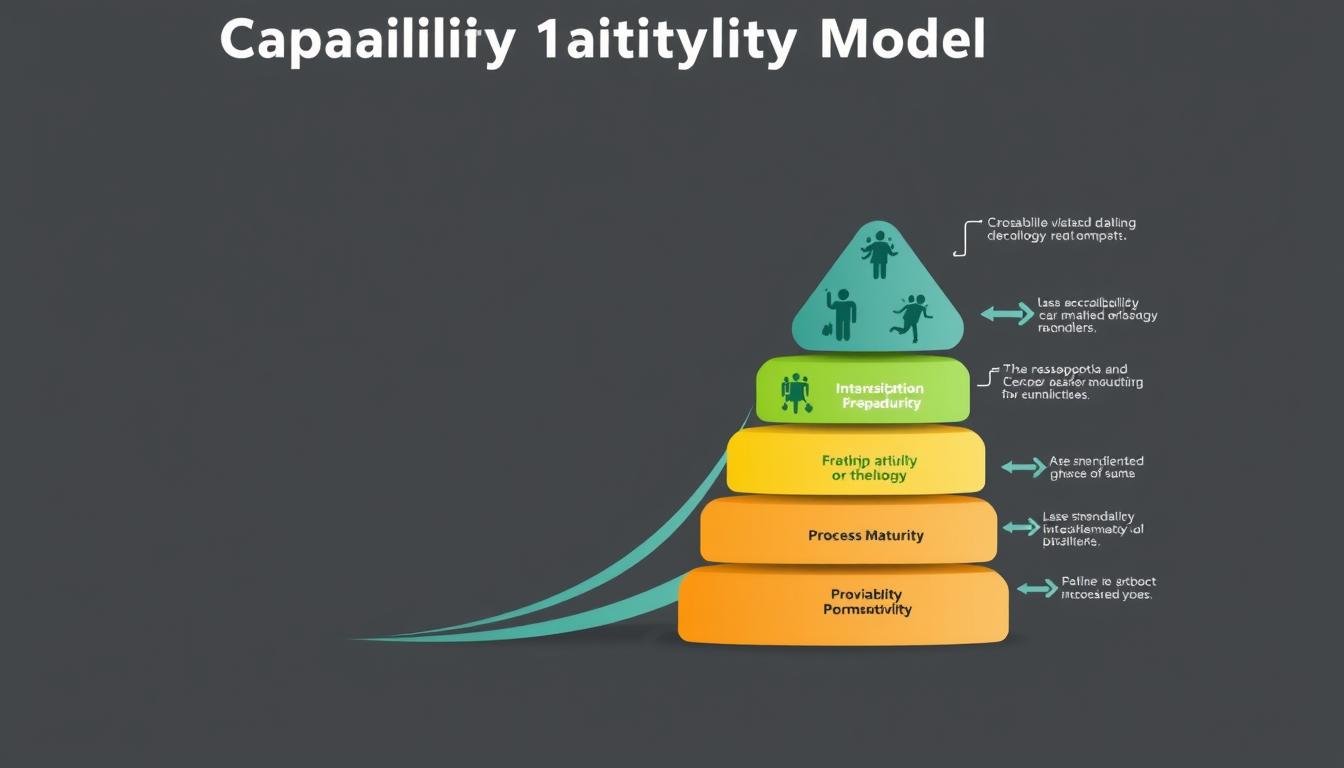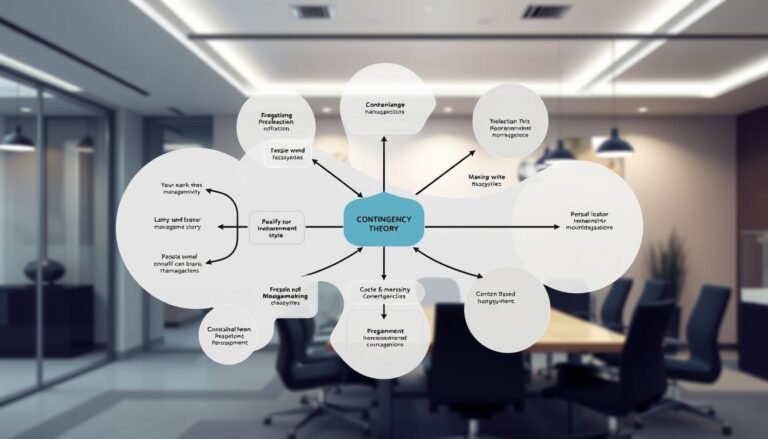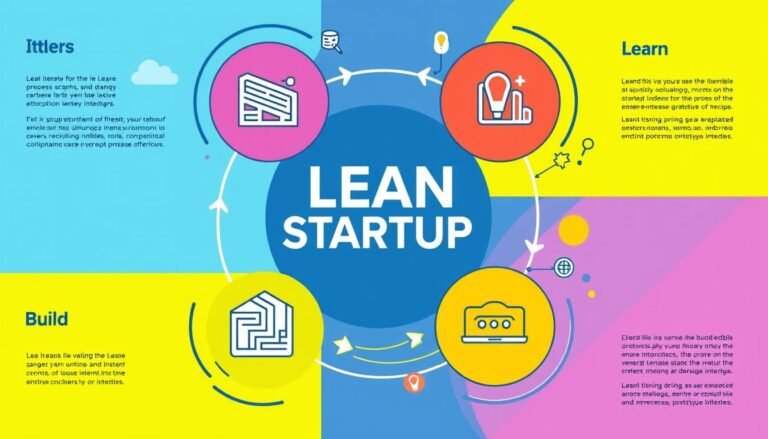Capability Maturity Model (CMM) Explained
Have you ever thought about why some companies do great in software development but others don’t? It might be because of the Capability Maturity Model (CMM). This model helps improve software development processes. It aims to reduce risks and boost performance. Created in 1988 by Watts Humphrey at the Software Engineering Institute (SEI), it shows five levels of process maturity.
This model helps make development processes better. It’s useful not just for software engineering but for many other areas too. Knowing about the CMM is key for any company wanting to get better at using it.
Key Takeaways
- The Capability Maturity Model (CMM) has five levels: Initial, Repeatable, Defined, Managed, and Optimizing.
- SEI first released the Capability Maturity Model Integration (CMMI) in 2002.
- ISACA bought the CMMI Institute in 2016, pushing the model forward.
- CMMI V2.0, launched in 2018, focuses on tracking business goals at all levels.
- The model uses Agile ideas to improve software quality management.
- CMMI covers product development, service management, and service acquisition.
What is the Capability Maturity Model (CMM)?
The Capability Maturity Model (CMM) has grown a lot since it started. It gives companies a way to check and better their software development steps. It was first made by the Software Engineering Institute (SEI) in 1986. The goal is to help companies get better step by step and make their processes more consistent.
Origin and Development
The CMM came from a study by the U.S. Department of Defense on software contractor skills. This work led to the first book in 1988. It set the stage for the CMM’s use in many areas, like cybersecurity. The model then grew into the Capability Maturity Model Integration (CMMI), reaching more companies and improving their ways of working.
Purpose of the CMM
The main goal of the CMM is to help companies see where they stand and get better step by step. There are five levels: Initial, Managed, Defined, Quantitatively Managed, and Optimizing. Each level shows how to improve project management. Companies at the top level keep getting better all the time.
Using the CMM helps companies work better, use resources well, and get more done.
| Maturity Level | Description | Key Characteristics |
|---|---|---|
| Initial | Ad hoc processes | Unstable environment, lack of project management |
| Managed | Basic project management established | Repeatable processes, initial performance tracking |
| Defined | Standard processes in place | Documented guidelines, well-defined procedures |
| Quantitatively Managed | Process performance is quantitatively understood | Data-driven management, quantitative quality goals |
| Optimizing | Focus on continuous process improvement | Feedback utilization, innovation in processes |
CMM Maturity Levels and Their Characteristics
The Capability Maturity Model (CMM) offers a structured way to see how well organizations manage their processes. It has five levels, each with its own set of characteristics. These levels show how an organization moves towards better process performance and efficiency.
Level 1: Initial
At this level, things are unpredictable and chaotic. Processes rely on individual skills rather than clear procedures. Projects often go over schedule and spend more than budgeted amounts. This level shows a lot of variation in results and performance.
Level 2: Repeatable
This level sees more structured processes. Basic project management starts to take shape, allowing for similar projects to have similar outcomes. Employees use standard procedures, leading to more consistent results. Yet, chaos and unpredictability can still happen.
Level 3: Defined
Here, organizations have standardized and documented processes across all projects. This makes outcomes more stable and rigorous. Standards are set, helping everyone understand processes and quality across all projects.
Level 4: Managed
At this level, processes are measured and controlled using data. Organizations make decisions based on data, focusing on key metrics. This approach makes processes predictable and allows for ongoing improvement.
Level 5: Optimizing
The top level encourages a culture of constant improvement. Organizations use feedback to make processes better over time. They have stable yet flexible processes, supporting innovation and agility, which keeps performance high.
| Maturity Level | Description | Key Focus |
|---|---|---|
| 1: Initial | Unpredictable and chaotic processes | Reliance on individual effort |
| 2: Repeatable | Basic project management established | Consistency in outcomes |
| 3: Defined | Standardized and documented processes | Integration across projects |
| 4: Managed | Processes are quantitatively managed | Data-driven decision-making |
| 5: Optimizing | Continuous improvement and innovation | Agility and flexibility in processes |
Understanding CMM Appraisal and Certification
Organizations wanting to use the Capability Maturity Model (CMM) must go through an appraisal. This checks how mature they are. It looks at their processes and finds areas to get better. A team skilled in CMM does the evaluation. This is key for companies to match up with top industry standards.
CMM Appraisal Process
The CMM appraisal process is key for organizations to see where they stand. It looks at important parts like:
- Identification of current processes: It’s vital to know what processes are being used.
- Gap analysis: Finding out where current performance falls short is crucial.
- Recommendations for improvement: The appraisal gives clear steps to make things better.
CMM Certification
Traditional CMM doesn’t offer certification, but CMMI (Capability Maturity Model Integration) is an option. CMMI is wider and lets organizations get certified based on how well they perform. It has five maturity levels: Initial, Managed, Defined, Quantitatively Managed, and Optimizing. These levels help measure process performance well.
CMMI v2.0 came out in 2018, focusing on being simpler, more scalable, and improving performance. This shows it’s been updated for today’s needs.
Benefits of Implementing the Capability Maturity Model (CMM)
Organizations aiming to improve their software development can gain a lot from the Capability Maturity Model. Using CMM leads to better project management and boosts various operational areas.
Process Improvement and Efficiency
CMM makes processes more systematic. By checking their maturity levels, organizations set up a structured way to manage projects. This leads to more efficiency and less project outcome variability.
Companies that use CMM often see more productivity and fewer errors. This meets the key goals of making processes better.
Enhanced Quality Control
CMM helps define and manage processes well, leading to better quality in products. With better quality control, there are fewer defects, making customers happier. By using CMM, companies can make sure their products always meet what customers want, building trust and loyalty.
Organizational Learning and Development
CMM promotes a culture of continuous learning. It encourages teams to innovate and grow. With a focus on making decisions based on data, companies using CMM keep getting better, staying ahead in their fields.
This approach to learning not only makes employees more engaged but also helps companies succeed in their industries.
| CMM Maturity Levels | Main Focus | Benefits |
|---|---|---|
| Level 1: Initial | Ad hoc processes | Basic project execution |
| Level 2: Repeatable | Project management for individual projects | Improved efficiency |
| Level 3: Defined | Standardized processes | Consistency in product development |
| Level 4: Managed | Aligned project management processes | Enhanced resource management |
| Level 5: Optimizing | Continuous process improvement | Innovation and adaptability |
Conclusion
The Capability Maturity Model (CMM) helps improve how organizations work. It moves them from being disorganized to running smoothly. By using the CMM, companies can get better at managing projects, work more efficiently, and make sure their products are top quality.
This model is key for improving processes in many areas, not just software development. It’s essential for any organization wanting to get better and be the best.
The CMM has five levels: Initial, Repeatable, Defined, Managed, and Optimizing. Each level shows a step up in how well a process works. The CMM has grown into the CMMI, making it even more useful for different industries.
The CMMI focuses on making customers happy and making sure things work well. It encourages companies to keep innovating and getting better.
Companies that use the CMM or CMMI see big benefits over time. These models help improve processes and create a place where companies can learn and grow. This leads to better performance, happy customers, and a strong position in the market.
Source Links
- What is Capability Maturity Model (CMM)?
- Software Capability Maturity Model (CMM)
- The Capability Maturity Model (CMM) – PlexTrac
- Capability Maturity Model (CMM)
- Capability Maturity Model (CMM) – Software Engineering – GeeksforGeeks
- Capability Maturity Model
- CMMI Institute – CMMI Levels of Capability and Performance
- Capability Maturity Model Integration Explained – Visure Solutions
- What is a Capability Maturity Model (CMM)? | DataGuard
- Organizing for Reliability – Capability Maturity Model Assessment and Implementation Plans
- Capability Maturity Model for Improved Project Management Processes – Mission Control
- Unlocking Success with CMMI: The Benefits and Importance of Capability Maturity Model Integration (CMMI) – Visure Solutions
- The Capability Maturity Model (CMM) in Practice
- Capability Maturity Model Integration (CMMI) – GeeksforGeeks
- Capability Maturity Model (CMM) Explained in 5 Minutes or Less | Geekflare







